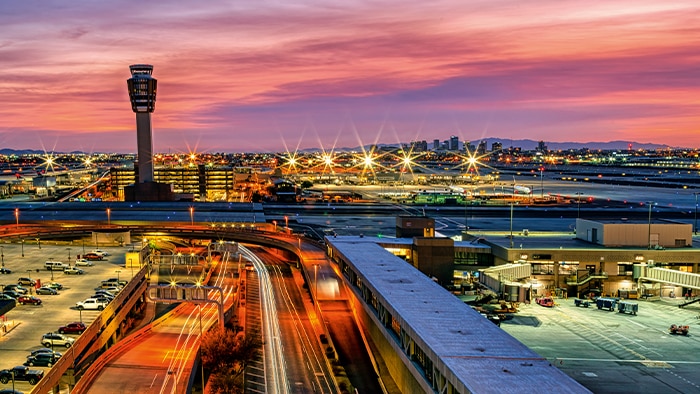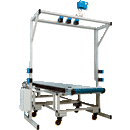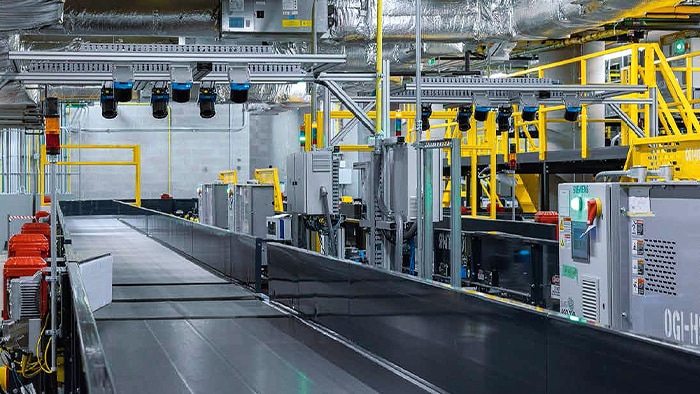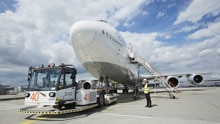After three years of construction, Phoenix Sky Harbor International Airport unveiled their upgraded concourse in April 2022. The airport integrated several components to create a high performance, seamless travel experience for their customers. With five explosives detection systems (EDS), a new inbound carousel, and a conveyor system to transport bags, they now have a more reliable system that can handle high-speed baggage handling. Automatic tag readers (ATRs) and bag dimensioners from SICK – stationed along 1.5 miles of conveyor belts – play a part in this increased reliability and capacity.
Automatic tag reading streamlines Phoenix airport advanced baggage handling system
The ticket to a better airport
The new South Concourse 1 of Terminal 4 underwent quite the transformation, now offering more than just a new baggage handling system. The 130,000 square-foot concourse houses eight additional gates and a slew of passenger amenities: restaurants and retail shops, charging stations, a common-use lounge, and a connector bridge to the north concourses in Terminal 4.
Restaurants, shops, and lounges upgrade any airport. But all the amenities in the world mean diddly squat when you log unwanted hours at the airport speaking to an airline representative and filing a lost baggage claim. But thanks to the advanced baggage handling system, PHX can process about 10,000 bags per day along 1.5 miles of conveyor belt for optimal efficiency.
According to the Airport Improvement Magazine, “They pored over design and model options carefully, intent on creating a baggage handling system that provides passengers only positive reasons to take notice.”
SICK’s bag dimensioners and camera-based ATRs are a part of the pored-over design. PHX implemented camera-based ALISVISION arrays; these ATRs have consistently good read rates and are especially good at reading bag tags that are poorly printed, damaged by handling, or partially hidden from view due to passenger flair – like passenger ID tags and ribbons.
How do sensors help with baggage?
ATRs are used where high baggage volume makes automatic reading necessary. For example, these are at the points in the baggage handling system where the bags must be clearly assigned to the X-rays, and in the sorting processes to automatically feed the bags to the assigned baggage loading station over long distances through the baggage handling system. There are still gaps in baggage identification, especially in transit and arrivals. This is why the International Air Transport Association (IATA) created Resolution 753, where airlines who are members of the IATA are required to keep exact inventory lists of baggage – from the time of bag check to return to the passenger. SICK can do the basic work to fulfill IATA Resolution 753: Reading information printed on the baggage label or saved in an RFID tag. This makes consistent baggage tracking possible. This ultimately leads to welcome cost reductions for airlines concerning mishandled baggage, which also increases customer satisfaction.

SICK working with PHX is not the first (airport) rodeo. SICK is a market leader in this field with a large installed basis for automatic reading systems for baggage labels.
The first systems from SICK were put into operation at the Paris Charles de Gaulle airport in 1990. Today, these reading systems are installed at the largest airports in the world, like Atlanta Hartsfield-Jackson, Dubai International, Tokyo Haneda, London Heathrow, Hong Kong International, and many more.
Designed for the long haul
While the expansion was built to accommodate the airport’s throughput, its design also accommodates future growth. The conveyor delivery system has room for an additional EDS machine, and there’s also room for another sortation carousel for outbound baggage, if needed. SICK values enduring solutions and is happy to contribute to a project with overall growth and expansion in mind, leading to increased efficiency and capabilities not just for the present, but the future as well.
“SICK ATRs have been a critical component of the PHX baggage handling system since 2007. We were honored to be selected by G&S Conveyor and the City of Phoenix for the camera-based ATRs and advanced Baggage Dimensioning Systems for this key expansion of Southwest’s capacity at PHX. This new baggage handling system will be processing bags at high throughput for many, many years to come and we look forward to our continued support of PHX,” says Tom Gebler, Account Director, Airport Systems.







